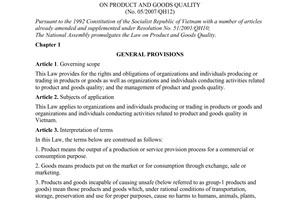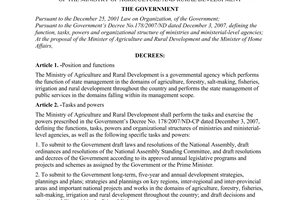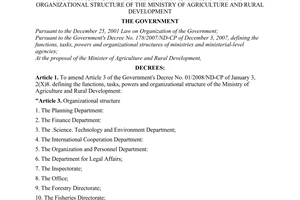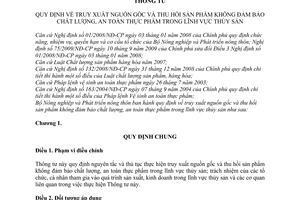Nội dung toàn văn Circular No. 03/2011/TT-BNNPTNT on tracing and recall of fishery products faili
|
THE
MINISTRY OF AGRICULTURE AND RURAL DEVELOPMENT |
SOCIALIST
REPUBLIC OF VIET NAM |
|
Hanoi, January 21, 2011 |
CIRCULAR
ON TRACING AND RECALL OF FISHERY PRODUCTS FAILING TO MEET FOOD QUALITY AND SAFETY REQUIREMENTS
Pursuant to the Government's
Decree No. 01/2008/ND-CP of January 3. 2008. defining the functions, tasks,
powers and organizational structure of the Ministry of Agriculture and Rural
Development: and the Government's Decree No. 75/2009/ND CP of September 10.
2009. amending Article 3 of Decree No. OI/2008/ND-CP of January 3, 2008:
Pursuant to the 2007 Law on Product and Goods Quality:
Pursuant to the Government's Decree No. 132/2008/ND CP of December 31. 2008.
detailing a number of articles of the Law on Product and Goods Quality:
Pursuant to the July 20. 2003 Ordinance on Food Hygiene and Safely:
Pursuant to the Government's Decree No.163/20D4/ND CP of September 7. 2004.
detailing a number of articles of die Ordinance on hood Hygiene and Safely:
The Ministry of Agriculture and Rural Development provides the tracing and
recall of fishery products failing to meet food quality and safety requirements
as follows:
Chapter I
GENERAL PROVISIONS
Article 1. Scope of regulation
This Circular provides principles and procedures for the tracing and recall of fishery products failing to meet food quality and safely requirements: and responsibilities of organizations and individuals engaged in fishery production and business, and agencies involved in the implementation of this Circular.
Article 2. Subjects of application
1. This Circular applies to fishery production and business establishments (below referred to as establishments):
a/ Fishing vessels with main engine capacity of 50 HP or higher: aquatic animal feed producers and traders: producers and traders of chemicals and products for aquaculture environment treatment and improvement; producers, traders and hatcheries of commercial aquatic animal seeds, and aquaculture establishments:
b/ Independent ice producers serving aquatic product preservation and processing: establishments procuring, preliminarily processing, storing, preserving, packing and processing aquatic products for domestic consumption:
c/ Export aquatic food processing vessels: establishments cleaning and supplying live bivalve mollusks (with products served raw): independent cold storehouses preserving aquatic products; establishments preliminarily processing, packing and processing aquatic products and having export products.
2. This Circular does not apply to households and individuals producing fishery products on a small scale for domestic use without sale in the market; and producers of products of aquatic origin which are not used as food.
Article 3. Interpretation of terms
In this Circular, the terms below are construed as follows:
1. Fishery products include aquatic animal feed; chemicals and products for aquaculture environment treatment and improvement: aquatic animal seeds: ice for aquatic product preservation and processing: seafood and aquatic products used as food.
2. Tracing means the possibility to monitor and locate a product unit through specific steps of production, processing and distribution (by Codex Alimentarius standards).
3. Product recall means taking measures to remove a product which fails to meet food quality and safely requirements from the chain of production, processing and distribution.
4. One step back-one step forward tracing principle means an establishment's storage of information that guarantees the identification of the producers and/or traders one step back and one step forward in the production, processing and distribution of a traced product.
5. Production lot (batch) means a specific quantity of goods produced according to the same technological process and under the same production conditions within an uninterrupted period of lime.
6. Lot of receipt means a quantity of materials procured and received once by an establishment for production.
7. Lot of delivery means a quantity of products of an establishment delivered once.
Article 4. Inspection and supervision agencies
Agencies inspecting and supervising the observance of regulations on tracing and recall of fishery products failing to meet food quality and safety requirements are:
1. The Directorate of Fisheries: and designated professional agencies under provincial-level Agriculture and Rural Development Departments, which shall inspect and supervise the establishments specified at Point a. Clause 1. Article 2 of this Circular in implementing this Circular.
2. The National Agro-Forestry-Fisheries Quality Assurance Department and its attached agencies and units, which shall inspect and supervise the establishments specified at Point c. Clause I. Article 2 of this Circular in implementing this Circular.
3. Agro-Forestry-Fisheries Quality Assurance Sub-Departments (or professional agencies designated by provincial-level Agriculture and Rural Development Departments in cities and provinces without an Agro-Forestry-Fisheries Quality Assurance Sub-Department), which shall inspect and supervise the establishments specified at Point b. Clause 2. Article 2 of this Circular in implementing this Circular.
Chapter II
TRACING AND PRODUCT RECALL
Article 5. Tracing
The establishments specified in Clause 1, Article 2 of this Circular shall establish a tracing system meeting the requirements provided in the Appendix to this Circular.
Article 6. Recall of lots of delivery
1. An establishment specified in Clause 1, Article 2 of this Circular shall adopt a policy to recall lots of delivery failing to meet food quality and safely requirements in the following cases:
a/ The establishment voluntarily recalls a lot of delivery when detecting that such lot is made from input materials which fail to meet food quality and safety requirements or is produced/ processed or preserved in the conditions failing to meet food quality and safety requirements;
b/ The establishment shall recall a lot of delivery at the request of an inspection and supervision agency in the following cases:
- The lot is requested by a competent agency of Vietnam or an importing country for recall or return for its failure to meet food quality and safety requirements;
- The lot is originated from an aquatic animal rearing establishment/area or harvesting area which is detected to fail to meet food quality and safety requirements within the scope of national surveillance programs for food hygiene and safety.
2. An establishment specified in Clause 1. Article 2 of this Circular shall establish procedures to recall kits of delivery, which must meet the requirements provided in the Appendix to this Circular.
Article 7. Tracing and recall of products at request of inspection and supervision agencies
1. Notice of recall: An inspection and supervision agency assigned under Article 4 of this Circular shall issue a notice requesting an establishment to trace and recall a lot of delivery which fails to meet food quality and safety requirements. This notice must contain the following information on the lot of delivery:
a/ Name of the establishment responsible for tracing and recalling the lot of delivery;
b/ Information to identify the lot in question (type, identification code, volume):
c/ Reason for tracing and recall;
d/ Scope of and deadline for recall.
2. Recall: After receiving a notice of recall, an establishment shall trace and recall a lot of delivery as follows:
a/ To identify the lot in question through the establishment's tracing system;
b/ To determine the lot and the scope of tracing and recall;
c/ To submit a recall plan to an inspection and supervision agency and to request its assistance in recall (when necessary);
d/ To recall and handle the lot:
e/ To report results to an inspection and supervision agency after recalling and handling the lot.
3. An inspection and supervision agency may-verify an establishment's product tracing and recall when necessary.
Chapter III
RESPONSIBILITIES OF INVOLVED PARTIES AND HANDLING OF VIOLATIONS
Article 8. The Directorate of Fisheries
1. To provide and detail regulations (including a system of establishment identification codes) on tracing and recall of fishery products failing to meet food quality and safety requirements applicable to the establishments specified at Point a. Clause 1, Article 2 of this Circular.
2. To direct and guide professional agencies under provincial-level Agriculture and Rural Development Departments in applying this Circular to the establishments specified at Point a, Clause L Article 2 of this Circular.
3. To inspect and supervise professional agencies under provincial-level Agriculture and Rural Development Departments in conducting inspection and supervision as assigned under Clause 1. Article 4 of this Circular.
Article 9. The National Agro-Forestry-Fisheries Quality Assurance Department
1. To provide and detail regulations on tracing and recall of fishery products failing to meet food quality and safety requirements applicable to the establishments specified at Points b and c. Clause 1. Article 2 of this Circular.
2. To direct and guide its attached units and Agro-Forestry-Fisheries Quality Assurance Sub- Departments or professional agencies assigned by provincial-level Agriculture and Rural Development Departments in inspecting and supervising the implementation of this Circular by the respective establishments specified at Points b and c. Clause .1. Article 2 of this Circular.
3. To inspect and supervise its attached units and Agro-Forestry-Fisheries Quality Assurance Sub-Departments or professional agencies of provincial-level Agriculture and Rural Development Departments in conducting inspection and supervision as assigned under Clauses 2 and 3, Article 4 of this Circular.
Article 10. Provincial-level Agriculture and Rural Development Departments
1. To direct their professional agencies in inspecting and supervising the implementation of this Circular as assigned under Clauses 1 and 3. Article 4 of this Circular.
2. Quarterly or upon request, to report to the Ministry of Agriculture and Rural Development (the Directorate of Fisheries or the National Agro-Forestry-Fisheries Quality Assurance Department) on tracing and recall of fishery products failing to meet food quality and safety-requirements in their localities.
Article 11. Establishments
1. To comply with the guidance of inspection and supervision agencies specified in Article 4 of this Circular and related laws.
2. To submit to inspection and supervision of the implementation of this Circular and handling measures provided by inspection and supervision agencies.
3. To comply with Articles 5 and 6. and Clause 2, Article 7. of this Circular and report to inspection and supervision agencies when so requested.
Article 12. Handling of violations
Inspection and supervision agencies shall consider and handle under the Ministry of Agriculture and Rural Development's regulations violations of this Circular as violations of conditions on food quality, hygiene and safety assurance for fisheries producers and traders.
Chapter IV
IMPLEMENTATION PROVISIONS
Article 13. Transitional provisions
1. This Circular applies on its effective dale to the establishments specified in Clause 1. Article 2 of this Circular.
2. This Circular applies on January 1. 2012. to fishing vessels with main engine capacity ranging from 50 I IP to under 90 HP.
Article 14. Effect
This Circular lakes effect 45 (forty -live.) days hum the date of its signing.
|
|
MINISTER
OF AGRICULTURE AND RURAL |
APPENDIX
REQUIREMENTS FOR TRACING AND RECALL OF FISHERY
PRODUCTS FAILING TO MEET FOOD QUALITY AND SAFELY REQUIREMENTS
( To Circular No. 03/2011/TT-BNNPTNT of January 21. 2011)
I. GENERAL REQUIREMENTS
I. For tracing:
a/ Establishments shall establish a tracing system under the one step back-one step forward principle to enable the identification and tracing of a product unit in specific steps of production, processing and distribution:
b/ Product origin must be traced through information, including the system of product identification codes (coding), stored throughout the production process of establishments:
c/ Establishments shall store and provide information which must enable the identification of production lots; lots of receipt, suppliers and lots of delivery and recipients:
d/ Establishments shall adopt measures to clearly separate lots of receipt, production lots and lots o (deli very to ensure accuracy of needed information.
2. For product recall: Establishments shall establish appropriate procedures which ensure recall and removal of products failing to meet food quality and safely requirements or likely causing food safely risks from establishments in the chain of production, distribution and sale.
3. The tracing system and procedures for recall of products failing to meet food quality and safely requirements must be reviewed and adjusted at least once a year to meet practical operation requirements of establishments.
II. TRACING SYSTEM
I. Establishment of a tracing system:
A tracing system must coven
a/ Scope of application of the system;
b/ Procedures for coding and identification of materials and semi-finished and finished products throughout the production process. Product coding procedures must ensure convenient tracing of necessary information on preceding production steps;
c/ Procedures for recording and storing dossiers in the production process;
d/ Procedures for regular inspection and revision of the system;
e/ Tracing procedures (Who? What to do? How to do? When?);
f/ Assignment of implementation responsibilities.
2. Information storage and provision: 2.1. Information storage:
2.1.1. 2.1.1 Information which must be stored in each establishment for tracing purposes:
a/ For a lot of receipt:
- Name, address and code (if any) of the supplier;
- Time and place of receipt;
- Information on the lot (type, volume, identification code).
b/ For a production lot: Information on the lot at each step (production time, type, volume, identification code of the lot/batch);
c/ For a lot of delivery:
- Name, address and code (if any) of the recipient;
- Time and place of delivery;
- Information on the lot (type, volume, identification code).
2.1.2. For a lot of aquatic materials imported for processing, an establishment must additionally store information on the exporting country.
2.1.3. A system of data management and coding of information for tracing must be stored in an appropriate medium ensuring convenient tracing. Dossiers must be stored for at least:
a/ Six (6) months, for raw aquatic products:
b/ Two (2) years, for frozen and processed aquatic products:
c/ One (1) production cycle, for each aquatic animal seed;
d/ Six (6) months after the expiry date of each aquatic animal feed or product for aquaculture environment treatment and improvement.
2.2. Information provision:
When supplying and distributing a lot of delivery, an establishment shall provide the recipient with information for tracing specified in Section 2.1.1 of this Appendix.
3. Tracing order and procedures:
An establishment shall trace products as follows:
a/ To receive the request for tracing a production lot/lot of delivery;
b/ To assess the necessity for such tracing:
c/ To identify the lot in question through archives;
d/ To identify production steps related to the lot in question;
e/ To find out causes and the step which is out of control;
f/ To propose handling measures;
g/ To make a report after completing the tracing.
4. Product recall:
4.1. Establishment of product recall procedures:
a/ To elaborate model recall plans:
b/ To apply on trial and approve model recall plans.
4.2. Product recall order and procedures:
a/ To receive a recall request;
b/ To assess the necessity of such recall;
c/ To adopt a recall plan (based on the approved model plan) and submit it to the leadership for approval;
d/ To recall the product under the approved plan.
e/ To make a report on recall and measures to handle the recalled lot and store dossiers. When such a recall affects establishments in the chain of production, processing and distribution, the establishment shall submit a report to an inspection and supervision agency.






